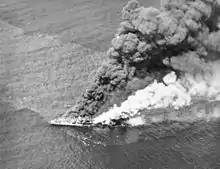Japanese destroyer Wakatsuki
Wakatsuki (若月) was an Akizuki-class destroyer of the Imperial Japanese Navy. Her name means "Young Moon".
 Wakatsuki under attack at Ormoc Bay, Leyte Island, Philippines, 11 November 1944. | |
| History | |
|---|---|
| Name: | Wakatsuki |
| Builder: | Mitsubishi Nagasaki Shipyard |
| Laid down: | 9 March 1942 |
| Launched: | 24 November 1942 |
| Completed: | 31 May 1943 |
| Commissioned: | 31 May 1943 |
| Stricken: | 10 January 1945 |
| Fate: | Sunk in action, 11 November 1944 |
| General characteristics | |
| Class and type: | Akizuki-class destroyer |
| Displacement: |
|
| Length: | 134.2 m (440 ft 3 in) |
| Beam: | 11.6 m (38 ft 1 in) |
| Draft: | 4.15 m (13 ft 7 in) |
| Propulsion: |
|
| Speed: | 33 knots (38 mph; 61 km/h) |
| Range: | 8,300 nmi (15,400 km) at 18 kn (21 mph; 33 km/h) |
| Complement: | 263 |
| Armament: |
|
Design and description
The Akizuki-class ships were originally designed as anti-aircraft escorts for carrier battle groups, but were modified with torpedo tubes and depth charges to meet the need for more general-purpose destroyer. Her crew numbered 300 officers and enlisted men. The ships measured 134.2 meters (440 ft 3 in) overall, with a beam of 11.6 meters (38 ft 1 in) and a draft of 4.15 meters (13 ft 7 in).[1] They displaced 2,744 metric tons (2,701 long tons) at standard load and 3,759 metric tons (3,700 long tons) at deep load.[2]
The ship had two Kampon geared steam turbines, each driving one propeller shaft, using steam provided by three Kampon water-tube boilers. The turbines were rated at a total of 52,000 indicated horsepower (39,000 kW) for a designed speed of 33 knots (61 km/h; 38 mph). The ship carried up to 1,097 long tons (1,115 t) of fuel oil which gave them a range of 8,300 nautical miles (15,400 km; 9,600 mi) at a speed of 18 knots (33 km/h; 21 mph).[3]
The main armament of the Akizuki class consisted of eight Type 98 100-millimeter (3.9 in) dual purpose guns in four twin-gun turrets, two superfiring pairs fore and aft of the superstructure. They carried four Type 96 25-millimeter (1.0 in) anti-aircraft guns in two twin-gun mounts. The ships were also armed with four 610-millimeter (24.0 in) torpedo tubes in a single quadruple traversing mount; one reload was carried for each tube. Their anti-submarine weapons comprised six depth charge throwers for which 72 depth charges were carried.[4]
Construction and career

The ship was commissioned on 31 May 1943 into the 11th Destroyer Squadron. Wakatsuki participated in rescuing sailors from Shōkaku (June 1944) and Zuikaku (October 1944) when each was sunk by US forces. Both of these carriers participated in the attack on Pearl Harbor.
On 11 November 1944, Wakatsuki was escorting a troop convoy to Ormoc, Philippines. She was sunk by aircraft of Task Force 38 in Ormoc Bay, west of Leyte (10°50′N 124°35′E).
Rediscovery
Wakatsuki's wreck was discovered in early December 2017 by Microsoft co-founder Paul Allen's research vessel RV Petrel 869 ft (265 m) below the surface of Ormoc Bay. She was found to be heavily damaged from both her sinking and impact with the seafloor, resting on her starboard side.[5]
Notes
- Chesneau, p. 195
- Whitley, p. 204
- Jentschura, Jung & Mickel, p. 150
- Whitley, pp. 204–05
- "Archived copy". Archived from the original on 2018-08-15. Retrieved 2018-10-15.CS1 maint: archived copy as title (link)
References
- Chesneau, Roger, ed. (1980). Conway's All the World's Fighting Ships 1922–1946. Greenwich, UK: Conway Maritime Press. ISBN 0-85177-146-7.
- Jentschura, Hansgeorg; Jung, Dieter & Mickel, Peter (1977). Warships of the Imperial Japanese Navy, 1869–1945. Annapolis, Maryland: United States Naval Institute. ISBN 0-87021-893-X.
- Whitley, M. J. (1988). Destroyers of World War 2. Annapolis, Maryland: Naval Institute Press. ISBN 0-87021-326-1.